Related Research Articles
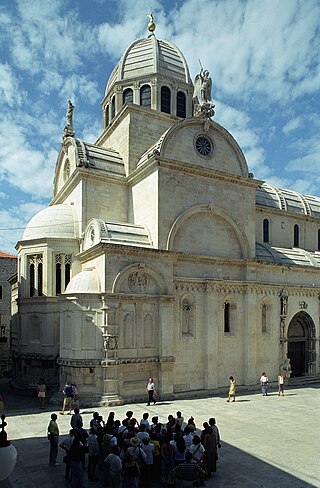
The Cathedral of St. James in Šibenik, Croatia, is a triple-nave Catholic basilica with three apses and a dome. It is the episcopal seat of the Šibenik diocese. It is also the most important architectural monument of the Renaissance in the entire country. Since 2000, the cathedral has been on the UNESCO World Heritage List.

Marsico Nuovo is a town and comune of the province of Potenza in the Basilicata region of southern Italy. It was the seat of the bishops of Grumentum.
Marsico may refer to two Italian municipalities:
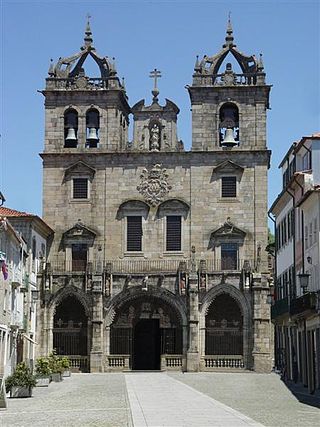
The Cathedral of Braga is a Roman Catholic church in the northern city of Braga, Portugal. Due to its long history and artistic significance, it is also one of the most important buildings in the country. It is the seat of the Archdiocese of Braga and of the Primate Archbishop of Portugal and Spain.
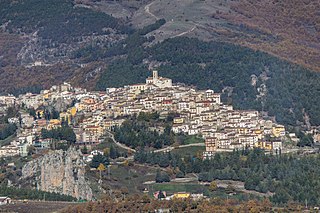
Abriola is a town and comune in the province of Potenza, in the Southern Italian region of Basilicata. It is bounded by the comuni of Anzi, Calvello, Marsico Nuovo, Pignola, Sasso di Castalda, Tito.

Sala Consilina is a town and comune in the province of Salerno in the Campania region of southwestern Italy. With 12,635 inhabitants it is the most populated town of Vallo di Diano.

Nicola Peccheneda was an Italian painter of Campania and Basilicata in the second half of the 18th century. He initially trained in Naples, likely in the studio of Francesco de Mura. He adopted the reigning style of Francesco Solimena. While he came from a family including professionals ; he moved back to his native Polla, and despite painting in the region, lived until he died.
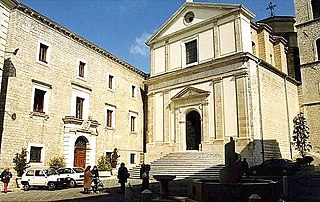
The Archdiocese of Potenza-Muro Lucano-Marsico Nuovo is a Latin diocese of the Catholic Church in Basilicata, southern Italy, created in 1986. In that year the Diocese of Muro Lucano was united into the Archdiocese of Potenza e Marsico Nuovo, which had been elevated to an archdiocese in 1973, and made a metropolitan see in 1976. The historical Diocese of Potenza was united with the Diocese of Marsico Nuovo in 1818.

The Archdiocese of Matera-Irsina is a Latin archdiocese of the Catholic Church in Basilicata, Italy. It has existed under this name since 1986. The archbishop is seated at Matera Cathedral.. It is a suffragan of the Archdiocese of Potenza-Muro Lucano-Marsico Nuovo.

The diocese of Marsico Nuovo was a Roman Catholic ecclesiastical territory in Basilicata, southern Italy, which existed until 1818. It was a suffragan of the archbishops of Salerno. In 1818, Marsico Nuovo was united aeque principaliter with the diocese of Potenza, to form the diocese of Marsico Nuovo and Potenza.

Christianity and religion in general has always been an important part of the social and cultural life of Naples. It is the seat of the Archdiocese of Naples, and the Catholic faith is highly important to the people of Naples and there are hundreds of historic churches in the city. The Cathedral of Naples is the most important place of worship in the city, each year on September 19 it hosts the Miracle of Saint Januarius, the city's patron saint. In the miracle which thousands of Neapolitans flock to witness, the dried blood of Januarius is said to turn to liquid when brought close to relics said to be of his body: this is one of the most important traditions for Neapolitans.
Luigi Pasquarelli was an Italian sculptor. Was bos from Antonio and Antonia Lauria. Pasquarelli completed his studies in Naples. He gained acclaim in 1877 in Naples for a marble group depicting: Un episodio di Pompei. Among his other works are: Pescatore amalfitano; Piccola ciociara; Fruttivendola; Busto muliebre; some portraits, many bassorilievi and funereal monuments. At Turin, in 1880, he exhibited a statue depicting: Un venditore napoletano di frutta. Minutes of a meeting of the council of Naples from 1872, document a trip to Brazil.

The Cathedral of San Gerardo is the main church or duomo of the city of Potenza, capital of the province of the same name, and of the region of Basilicata, Italy. Since 1986 Potenza forms part of the archdiocese of "Potenza-Muro Lucano-Marsico Nuovo".

Rapolla Cathedral is a Roman Catholic cathedral in the town of Rapolla, province of Potenza, region of Basilicata, Italy. The dedication is to Saint Michael the Archangel. Formerly the episcopal seat of the Diocese of Rapolla, it is now a co-cathedral in the Diocese of Melfi-Rapolla-Venosa.

Marsico Nuovo Cathedral is a Roman Catholic cathedral, dedicated to the Assumption of the Virgin Mary and Saint George, in the town of Marsico Nuovo, province of Potenza, region of Basilicata, Italy. It stands on a hill that rises above the town. Formerly the seat of the diocese of Marsico Nuovo, it has been a co-cathedral within the Archdiocese of Potenza-Muro Lucano-Marsico Nuovo since 1986.
San Michele Arcangelo is a Roman Catholic church located on Largo San Gianuario, in front of the more imposing church of San Gianuario in the town of Marsico Nuovo, province of Potenza, region of Basilicata, Italy.
San Gianuario is a Roman Catholic church located on Largo San Gianuario, in front of the church of San Michele Arcangelo, in the town of Marsico Nuovo, province of Potenza, region of Basilicata, Italy. It is cited as the co-cathedral of the town along with the church of San Giorgio.
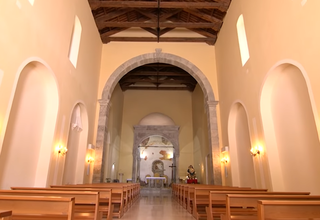
Santa Maria di Costantinopoli is a Roman Catholic church located on Via Santa Maria just outside the town of Marsico Nuovo, near the site of an old bridge over the river Agri, province of Potenza, region of Basilicata, Italy.
The Chiesa della Madonna del Carmine is a Roman Catholic church located on Via Raia Occidentale in the town of Marsico Nuovo, province of Potenza, region of Basilicata, Italy.
References
- ↑ Basileus online Basilicata website.